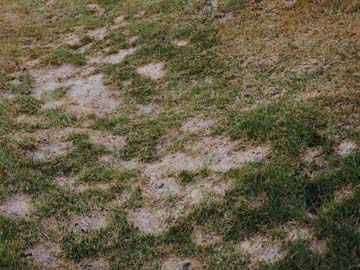Have you noticed roughly circular patches a few inches to 1 or 2 feet in diameter with matted down turfgrass leaves in your lawn? If so, you are most likely seeing the end result of a turfgrass disease called snow mold.
 Lawn showing circular, matted down patches that are the result of snow mold.
Lawn showing circular, matted down patches that are the result of snow mold.
The two most common types of snow mold are gray snow mold and pink snow mold. Gray snow mold and pink snow mold are fungal pathogens that grow under the protection of a snow cover and are most severe following winters with extended periods of snow cover. Gray snow mold only occurs under snow cover while pink snow mold will grow under snow cover and also during periods of cool, damp weather in the absence of snow cover.
In late winter or early spring as the snow melts and the matted down patches of turfgrass are observed, it is too late to control the snow mold pathogens. The damage is already done and your efforts should be focused on helping the turfgrass recover.
In many cases only the leaves of the turfgrass plants are dead and the growing point of the plant, the crown, which is located near the soil surface has survived. New leaves will come from the crown and those new leaves need a chance to break through the matted down dead leaves.
The first step in the recovery process is to use a heavy rake to break up the matted down patches of turfgrass. Go over the matted down area several times with the rake to break up the crust of matted down leaves. By breaking up the crust of matted down leaves, surviving plants will be able to grow as the weather warms up and the new leaves will not be held back by the crust of matted down leaves.
Be patient while waiting for the areas damaged by snow mold to recover. Turfgrass grows very slowly during the cool temperatures of early spring. It will take until mid to late May for the damaged areas to start to fill in and recover and complete recovery should be achieved by mid- June.
In extreme cases where the crown, or growing point, of the turfgrass plant has been killed and limited or no recovery is observed, it is time to reseed. In situations like this where several or numerous small patches of dead grass are present it makes sense to use a product that contains seed, mulch and fertilizer.
Use a heavy rake to remove all the dead grass from the damaged areas. Use the rake or a shovel to loosen the top ¼–½ inch of soil to create a good seed bed. Spread the seed, mulch and fertilizer combination product following label directions and water regularly until the seed has become well established.
Again, be patient. It will take two to four weeks for the seed to germinate depending on temperature. The cooler the temperatures, the longer it will take the seed to germinate. And it will take six to eight weeks after the seed germinates for the new seed to become well established.
A couple words of caution if you plan to reseed the damaged areas: first, do not apply a preemergent herbicide over the damaged areas where you plan to reseed. The preemergent herbicide that controls crabgrass seed will also prevent turfgrass seed from germinating. Second, wait until the new grass reaches the height of the existing grass and has been mowed two or three times before applying a herbicide that will control broadleaf weeds.
In many cases, breaking up the areas of matted down leaves with a rake and letting the turfgrass recover on its own will address areas damaged by snow mold. It will take several weeks of warm spring weather for the grass to recover in the damaged area.
Clark Throssell, Ph.D., is a turfgrass scientist and LebanonTurf staff member.